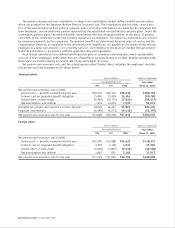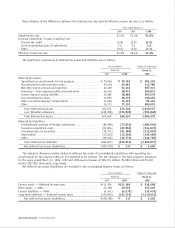Sony 1998 Annual Report Download - page 64
Download and view the complete annual report
Please find page 64 of the 1998 Sony annual report below. You can navigate through the pages in the report by either clicking on the pages listed below, or by using the keyword search tool below to find specific information within the annual report.[62] Sony Corporation Annual Report 1998
Following are explanatory notes regarding the financial assets and liabilities and off-balance-sheet financial
instruments.
Cash and cash equivalents, time deposits and notes and accounts receivable, trade
In the normal course of business, substantially all cash and cash equivalents, time deposits and notes and accounts
receivable, trade, are highly liquid and are carried at amounts which approximate fair value.
Notes and accounts payable, trade
In the normal course of business, substantially all notes and accounts payable, trade, are to be paid currently and
their carrying amounts approximate fair value.
Short-term borrowings and long-term debt
The fair values of short-term borrowings and total long-term debt, including the current portion, were estimated
based on the discounted amounts of future cash flows using the company’s current incremental borrowing rates for
similar liabilities.
Derivative financial instruments
The company utilizes foreign exchange forward contracts and foreign currency option contracts primarily to fix the
cash flow value resulting from accounts receivable and payable and future transactions denominated in foreign cur-
rencies in relation to the core currencies (Japanese yen, U.S. dollars, and German marks) of the company’s major op-
erating units. Foreign exchange forward contracts, the majority of which mature within three months, are used to
hedge this risk which is substantially associated with accounts receivable and payable and anticipated transactions
denominated in foreign currencies. The contracted amounts outstanding at March 31, 1997 and 1998 were ¥756,294
million and ¥733,020 million ($5,553,182 thousand), respectively. The fair values of these contracts were estimated
based on market quotations.
The company has entered into interest rate swap agreements and interest rate and currency swap agreements
which mature from 1998 to 2006 to reduce its exposure to losses resulting from adverse fluctuations in interest rates
or foreign currency exchange rates on underlying debt instruments. At March 31, 1997 and 1998, the aggregate
notional principal amounts of the interest rate swap agreements were ¥176,705 million and ¥91,235 million
($691,174 thousand), respectively, and those of the interest rate and currency swap agreements were ¥300,269
million and ¥430,297 million ($3,259,826 thousand), respectively. The fair values of such agreements were esti-
mated based on the discounted amounts of net future cash flows.
The company has entered into purchased foreign currency option contracts in the notional amounts of ¥196,990
million and ¥233,184 million ($1,766,545 thousand) at March 31, 1997 and 1998, respectively. The majority of these
contracts expire within three months of the balance sheet dates. The company has also entered into written foreign
currency option contracts in the notional amounts of ¥185,621 million and ¥279,406 million ($2,116,712 thousand) at
March 31, 1997 and 1998, respectively. The majority of these contracts are part of range forward contract arrangements
and expire in the same month with the corresponding purchased foreign currency option contracts described above. The
fair values of such foreign currency options were estimated based on values quoted by brokers.
A consolidated insurance subsidiary has entered into written government bond option contracts as an integral part
of short-term investing activities in order to fix the yields from bonds on hand to certain ranges. All of these contracts
expire within two months of the balance sheet date and their notional principal amounts were ¥204,945 million and
¥181,509 million ($1,375,068 thousand) at March 31, 1997 and 1998, respectively. For accounting purposes, those
transactions do not qualify for hedge accounting. Accordingly, those written bond option contracts were marked to
market. The fair values of such written bond option contracts were estimated based on market quotations.
























